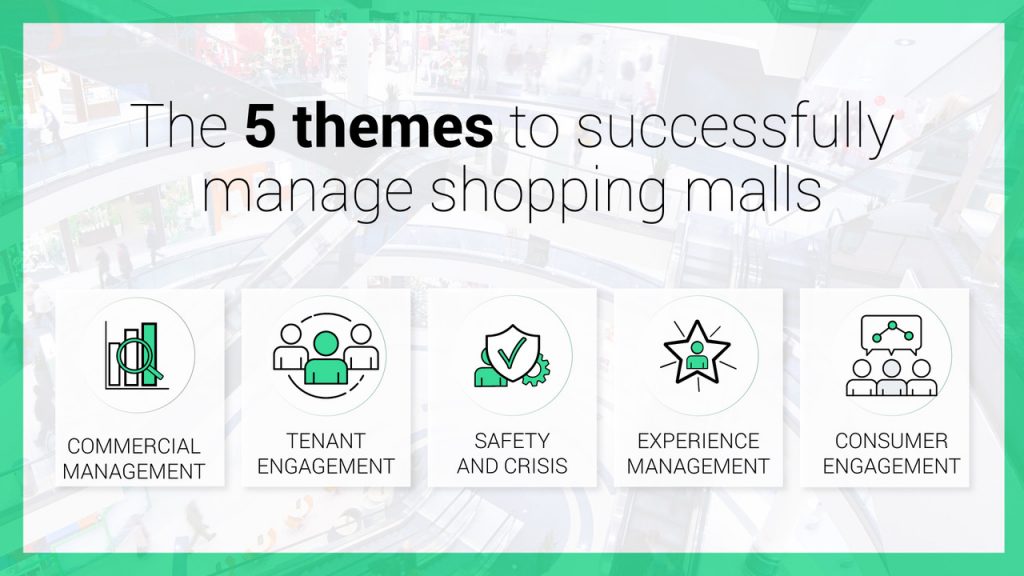By Hannu Käki
To better meet current and future customer expectations, shopping mall management needs to keep improving several fields in their business. At HyperIn we do our best to understand these fields and help landlords to succeed in those areas. In the following we will go through five themes in shopping mall management we believe to be very meaningful for a successful post-Covid era.

Commercial management
Efficient processes in mall management are the most vital components for being able to compete with eCommerce. Smooth daily workflows give freedom in the capacity to better serve tenants and consumers, while providing space for creativity. The management team needs to understand the commercial performance of the mall in ever shorter intervals. Reporting of sales used to be enough on a monthly basis but nowadays daily sales figures are necessary in many centers. However, the basic figures are not enough anymore. Data needs to be viewed, extracted and enriched more easily. This also means that different solutions have to seamlessly communicate with each other in the same ecosystem.
With media sales tools, mall operators can monetize empty retail spaces and sell online physical and digital advertisements. Especially the specialty leasing of promotional places and pop-up shops are an efficient way to generate new recurring revenue streams. Even 10% growth can be achieved in annual retail real estate revenues with online bookings derived from non-rental sources, like paid advertisements and campaigns from brand marketers even in challenging times with unexceptional opening hours.
Within the past years, machine learning has started to help increasingly with various decisions. For example, in the analysis and future projections of the shopping mall performance, artificial intelligence can offer further benefits for management to take corrective actions and find the right solutions for the next steps.
Tenant Engagement
Close cooperation between mall management and tenants has been emphasized during the past months. Both parties have to be on the same side when they plan upcoming activities. Mall management communicates via multiple channels simultaneously with tenants and consumers. Tenants need to be engaged to contribute to the different activities planned by mall management. One part of any successful cooperation is the capability to analyze and learn from the results together with the tenants.
Safety and Crisis
This year has shown us very clearly that to maintain the trust of the visitors, management needs to communicate safety issues in a clear and the fastest possible way.
When mall employees and visitors understand the recommended guidelines, the experience for everyone will become more positive. Sometimes a large community of people can face unexpected situations and management needs to be able to react. Quick and easy internal communication tools are the cornerstone of everything, and let’s not forget the integration of external stakeholders, such as authorities.
Experience management
Hyper-local environments offer a unique mix of products and services as “lifestyle destinations” and “meeting places”. To deliver these experiences, management has to plan and organize various events and campaigns together with their tenants. Successful preparation can involve keeping hundreds of mall employees up-to-date on what is happening. And successful execution involves communication via multiple consumer channels to reach the right target audience and eventually convert their interests into sales during their visit of the organized event.
Consumer Engagement
Future brick-and-mortar retail customers expect to have a seamless digital and physical experience on their consumer journey. Customers appreciate campaigns that are tailored to their needs and that the information is available on multiple channels, both at physical locations and online. Multi-channel communication offers options for a wider reach, but when competing with eCommerce, the reach needs to be a rather smart interaction with the customer. Targeted messages at the right time are something that customers appreciate as an integral part of their journey. The experience can be enriched further with new augmented and virtual reality (AR/VR) applications. Eventually, the same means of learning algorithms that are used in eCommerce will support a great customer experience at physical retail destinations.
At HyperIn we have been working on building an ecosystem for our customers, the operators of the shopping malls for over a decade in order for them to succeed in these areas. From the very beginning our vision has been to help consumers in hyper-local retail environments. Now more than ever, this is driving us to facilitate the success of our customers and the industry.





